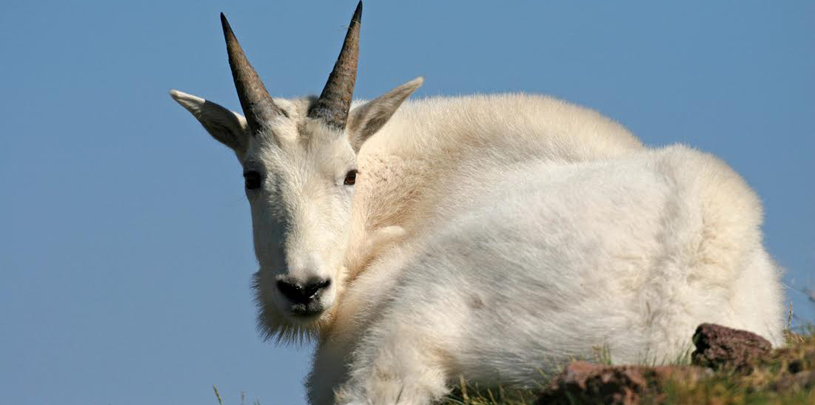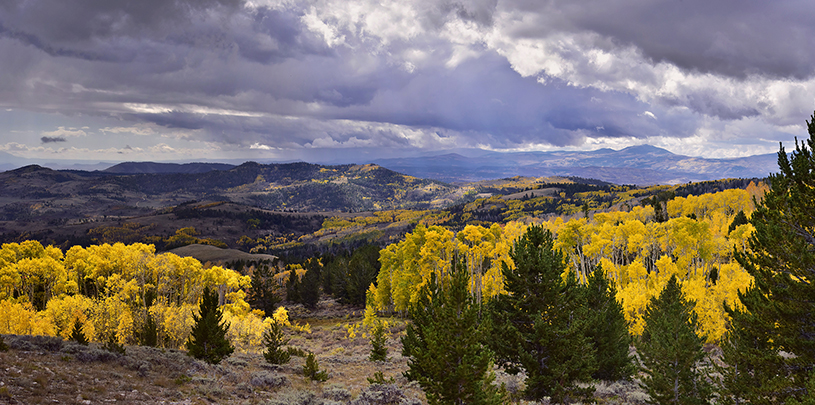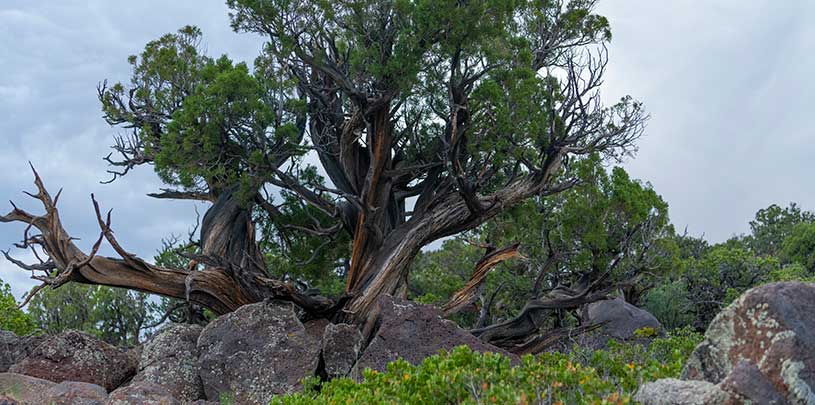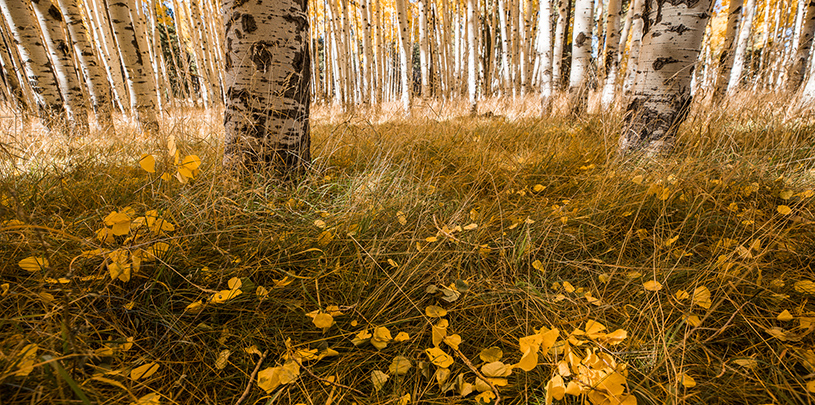
by Mary O’Brien, Director of Utah Forests
High Country News writer Krista Langlois trekked above 11,000 feet in the La Sal Mountains of SE Utah with a group of volunteers and Forest Service wildlife biologist Barb Smith to understand what is at stake with a fast-expanding herd of exotic mountain goats of concern to both the Forest Service and the Grand Canyon Trust. Krista captures the high debate in this December 22, 2014 article. Special thanks to High Country News for allowing us to re-print the full article here:
Non-native goats in Utah’s La Sal Mountains
How bad are these ungulates for the ecosystem?
By Krista Langlois/High Country News
The La Sal Mountains rise from the slickrock canyons and dry mesas of the Colorado Plateau like a mirage, an island of alpine peaks in a sea of desert. Just 15 miles from the adventure tourism hub of Moab, the mountains are blissfully cool, even in summer, and nearly empty of people.
To Barb Smith, a 52-year-old Forest Service wildlife biologist with striking green eyes and a silvery braid, the upper La Sals are an ecological paradise, one of the few chunks of land in Utah that isn’t grazed, logged or scarred by off-road vehicles. Smith is also a botanist, and as she and a dozen or so volunteers climb above 11,000-foot Burro Pass, she rattles off the Latin names of flowers:Polygonum bistortoides, Tetraneuris grandiflora. There are so many, it’s hard to take a step without crushing one.
We pause on a wind-scoured slope to catch our breaths and everyone crowds around Smith, who has spotted a cute if unremarkable yellow button called the La Sal daisy. She explains how to identify the flower and mark its location on a GPS. “This kind of effort, this kind of documentation, is going to be really helpful,” Smith says. The volunteers hold out their smartphones to take pictures.
The La Sal daisy grows nowhere else in the world, and no one knows how it’s been faring in the drier winters lately plaguing these mountains. Smith has spent the past five years trying to find out, gathering baseline data on the daisy to use as a marker to measure the effects of climate change. Until recently, she’s had a near-perfect place to do so: the Mount Peale Research Natural Area, a 2,300-acre preserve surrounding the La Sals’ highest peak. There are 29 research natural areas in Utah, each meant to protect a specific biome from human influence so that biologists like Smith can observe long-term ecological changes there, and use as a control against which to compare the effects of human activity on similar environments.
Lately, though, Smith’s work has taken on a new urgency: Last year, despite opposition from the regional Forest Service office and a cadre of local and national environmental groups, the Utah Division of Wildlife Resources released 20 non-native Rocky Mountain goats into the La Sals for hunting and wildlife viewing. This September, they released 15 more. Eventually, they hope to increase the population to 200.
To Smith, the goats defeat the very purpose of Mount Peale, which is supposed to be maintained in a natural state without human influence. She and other Forest Service biologists worry that the voracious, sharp-hooved goats will undermine research and irreversibly alter a fragile alpine ecosystem. But many of the volunteers who are here to help her collect data — mainly in hopes of convincing Utah officials to remove the goats or at least limit their numbers — are opposed to the animals on more philosophical terms. “This is our backyard mountain range,” says Paul Frank, a desert tortoise biologist who’s been coming to these mountains nearly every week since the 1970s. “And we don’t want invasive species here.”
State wildlife officials say that not every introduced species ends up being a problem, and that goats have been transplanted to other Utah mountain ranges with no ill effects. But that argument holds little weight with Mary O’Brien, who marches along behind Smith as we continue to climb higher into the ominous storm clouds settling over the La Sals.
O’Brien, a wiry 68-year-old botanist with close-cropped gray hair and a sun-worn face, is the unofficial leader of the anti-goat movement. She grew up in east Los Angeles, the daughter of a Skid Row social worker and a minister, and though her family had little money, they spent two weeks every summer in Kings Canyon while her father preached in an open-air chapel. The experience shaped O’Brien’s life: Today, as Utah Forest Program director of the nonprofit Grand Canyon Trust, she lives in a straw-bale house in the shadow of the La Sals and spends most of her time trying to protect public land from overgrazing and overuse. “Every cell in my body says that national public land exists so a kid from East L.A. can come up here and wander around,” she says.
Though my own fingers are so cold I can hardly hold a pen, O’Brien — who refuses to wear close-toed shoes — strides across the ridge in a pair of Chaco sandals, unfazed. As the storm begins to batter the mountains, she stops to throw her hands up, framed against the dark clouds. “We’re losing alpine areas to climate change,” she says. “And then, for very little reason at all, we introduce an exotic ungulate. Why not elephants? Don’t you think it would be neat to have elephants up here?”
She hikes on.
Thirteen months earlier, on June 4, 2013, O’Brien sat in the back of a Utah Wildlife Board meeting in downtown Salt Lake City and listened patiently as the eight-person, governor-appointed board went through the usual formalities. Then the discussion turned to the issue that most of the 60 or so attendees had come for: whether or not to put mountain goats in the La Sals.
Mountain goats aren’t native to Utah, but since the 1960s, they’ve been introduced to a dozen mountains around the state for hunters and wildlife aficionados. Despite the fact that Utah is several degrees in latitude below the goats’ native range in Washington, Idaho and Montana, the animals are thriving. There are now some 2,000 of them, and they’re extraordinarily popular: In 2012, 7,999 hunters applied for the 161 available tags, which cost between $400 and $1,500. A mountain goat viewing in Beaver, Utah, brought 2,000 tourists to the town of 2,500.
Justin Shannon, the big game coordinator for Utah’s Division of Wildlife Resources, was also at the meeting, making the case that goats do more good than harm. “As an agency, if we have an opportunity to expand our wildlife populations for the hunting and viewing public, we go for it,” he told me later. Like all big game in Utah, the goats and their habitat will be carefully monitored, and any damage will be mitigated by reducing the population. With goat populations decreasing in parts of their native range, some biologists think that transplants in Utah, Colorado, Nevada and elsewhere may even help the species survive.
But why put them in the isolated La Sals? Shannon told the board that the state is simply restoring an ungulate to an alpine community: Bighorn sheep were sighted in the mountains in the 1940s and ’50s, but can’t be introduced because they’ll contract diseases from the domestic sheep that graze at lower elevations. Goats, then, are the next best thing. Decades of study by state biologists elsewhere in Utah show no negative impacts on habitat or vegetation — a fact that the Utah Bowmans’ Association, Sportsmen for Fish and Wildlife and other hunting advocates reiterated at the wildlife board’s meeting.
But many Utahns who traveled to Salt Lake City for the chance to speak to the board — including mayors and commissioners from decidedly conservative counties — dispute that logic. The La Sals are smaller, drier and less well-vegetated than other ranges where goats have been introduced. With limited forage and a higher proposed goat density (four per square mile in the La Sals compared to 1.7 elsewhere), the anti-goat faction fears the animals will trample and overgraze alpine ecosystems. There’s also a question over the methodology of state studies, and no evidence that bighorn sheep actually lived in the La Sals to begin with: “One sighting by somebody … is not substantiation that (sheep) used to be up there all the time, regularly grazing,” Chris Baird, executive director of the Canyonlands Watershed Council, told the board.
Though the debate remained civil, the atmosphere in the room was intense. At one point, after someone expressed concerns that goats in Washington and Montana had harassed and even killed hikers, Shannon spoke up: “A few months ago we got report of a beaver that bit a guy on an artery and killed him. A beaver. But we are not going to (wage) war on beavers because someone had a bad experience.”
At its next meeting, the board voted 4-2 in favor of introduction.
A month later, in September 2013, three goats and a kid were munching alpine forb in central Utah’s Tushar Mountains, where goats were already doing so well that their numbers were roughly double the target population of 125. When the whup of helicopter blades interrupted their meal, one goat bolted, dodging trees and dashing across bare rock. The helicopter followed, flying low.
A balled-up net exploded into the air, and the helicopter banked and landed. A state wildlife official rushed out to the entangled goat, which thrashed wildly for a moment before being fitted with an orange blindfold. Then it was laced into a sling and airlifted out of the mountains, along with 19 other animals who would become the first of their species ever to roam the La Sals. The Salt Lake Tribune concluded that the operation was “the start of a grand adventure for the billies, nannies and kids.”
State wildlife biologist Riley Peck agreed, telling the Tribunethat goats “bring joy to a lot of people.” The transplants, he said, have been “a fantastic success as far as I’m concerned.”
Other wildlife introductions haven’t gone so smoothly: Biologists who tried to reintroduce native grizzly bears to Montana’s Bitterroot Mountains in 2000 received death threats, and a scientist who suggested bringing new bears to bolster an existing population in Washington’s North Cascades was spat on at a public meeting. Exotic ungulates that can be hunted, on the other hand, are generally welcome.
Between 2005 and 2007, for example, Colorado imported 91 moose to Grand Mesa on the state’s Western Slope for hunting and wildlife watching. Roger Shenkel, the local physician who helped hatch the plan, said that every time he drove by a particular bog, he felt like he ought to see a moose there. “People just love seeing moose,” he told the Grand Junction Daily Sentinel. Never mind that the largest tabletop mountain in the world evolved without them: It simply looked like moose ought to be there. Today, there are an estimated 380.
Mountain goats, equally beloved by hunters and children’s book authors, are also appealing. In 2005, Oregon wildlife officials tried to introduce non-native goats to the Columbia River Gorge National Scenic Area. The nonprofit Friends of the Columbia Gorge, fearing that the animals would damage endemic wildflowers, sued the Oregon Department of Fish and Wildlife and the U.S. Forest Service. A federal district court ordered a National Environmental Policy Act review, but the agencies instead withdrew the proposal. “Any national forest land requires a special use permit to (bring in) a new species,” explains Nathan Baker, a lawyer who represented the Friends. “And there was really no environmental analysis whatsoever.”
O’Brien believes that a similar process would convince a judge that the La Sal goats will also harm native flora, and are in violation of Forest Service policy. But though she, Barb Smith and the other volunteers crawling around looking for blooms at 11,000 feet care more about plants than most people do, their fight isn’t about flowers. It isn’t about goats. It’s about protecting this particular place, in its entirety, from the notion that by eliminating some species and introducing others, we can re-shape wild places to what we think they ought to be.
As the storm clouds spit icy rain onto the ridge above Burro Pass, O’Brien cinches the hood of her rain jacket, puts on a pair of gloves and resolutely jabs at her GPS. “In decades,” she says, looking across the gnarled spruce and July snow to the ochre plateau below, “someone will come up here and see the big sunflowers and say, ‘Oh, that’s pretty.’ They’ll never know there were these other eight species that grew only here. They’ll never know what these views used to look like when the mountains were covered with flowers.”
This story was originally published in the Dec. 22, 2014 issue of High Country News (hcn.org).




